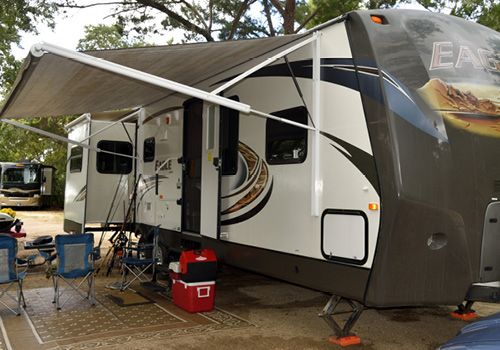
Keep Your RV Exterior in Tip Top Shape!
RVs are a BIG investment so you want to make sure you keep yours in tip top condition by doing regular maintenance.
Here are some tips from Go RVing Canada on how to take care of your RV Exterior!
Whether you’re a newbie to RV living or a seasoned RVer, you’ll want to stay on top of maintenance so you can enjoy your RV investment for many years to come. Exterior maintenance is a great place to start. We’ve got you covered with this handy checklist of maintenance tips to keep your RV exterior in top shape.
1. WASH your RV exterior after each trip
A sponge wash with mild soap and water rinse does the trick. But make sure you wash your RV exterior regularl, ideally, after you return from each trip. Be careful to prevent condensation and avoid spraying water directly into appliance vents.
2. WAX or apply a protectant to your RV exterior
Wax on, wax off ‘ channel your inner Karate Kid and apply a coat of good quality wax or protectant to your RV exterior. This can be a time-consuming task ‘ depending on the size of your RV ‘ but it’s well worth the effort. Make sure the exterior is dry before you start waxing and spot-test on a small area of graphics before widespread application. Check to ensure that the wax is appropriate for use on the type of exterior on your RV.
3. CLEAN your awning and keep it dry for storage
Before you roll up your RV awning for storage, clean it well with mild soap and water, and lubricate moving parts with silicon spray. When you roll it up, ensure that the awning is in the ‘lock’ position.
4. INSPECT any sealed areas thoroughly to prevent water damage
Your RV is out and about in the elements day-after-day on your adventures throughout the seasons. You’ll want to make sure that your RV exterior – including the roof, sides, edges, windows, doors, vents, end caps, moldings, compartments and underside – are sealed off and doing their job to protect the interior from potential water damage, mice or other rodents. Look for any gaps, openings or areas with aged sealant and re-caulk if necessary. Make sure to use the appropriate sealant and when in doubt, ask your RV dealer or manufacturer for advice.
5. LUBRICATE all hinges, locks and moving parts
No one likes a creaky door or window or compartment for that matter. Lubricating hinges and moving parts and all locks with a graphite spray lubricant is an easy maintenance step that takes only a couple of minutes. Lubricate your slide-out rails a couple of time a year to stop rust and corrosion.
6. COVER outside vents to keep the critters (and condensation) away
Keep the insects out and prevent nesting by installing plastic bags or covers on outside vents (furnace, refrigerator, water heater) for long-term storage. Buy a proper A/C cover (versus using a plastic bag) and cover your air conditioning unit to avoid condensation during storage.
7. STORE INDOORS, if possible
In the winter months, you’ll want to periodically check for snow accumulation and remove ice/snow from the RV exterior. Ideally, store your RV indoors when not in use as this will provide some extra protection from the elements.
Always park on solid, dry ground when storing. It’s also a good idea to leave a gap in your tarp. When covering the unit with a plastic tarp make sure to leave an air gap between the roof and tarp for air circulation. Without this, condensation might cause more damage than rain and snow.
8. COVER YOUR ROOF, if possible
RV roofs are especially susceptible to sun and environmental damage. Unfortunately, we often forget about our roofs because we don’t get up there regularly, which can lead to thousands of dollars in repairs. The best thing you can do to prevent this is store your RV under a steel RV carport or traditional RV cover. If you’re a full-timer, you will want to climb up and clean the roof regularly.